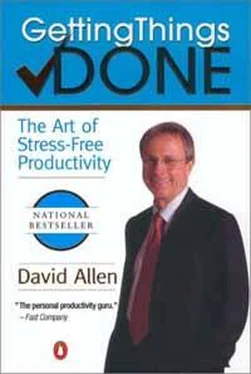The Moment-to-Moment Balancing Act
At the black-belt level, you can shift like lightning from one foot to the other and back again. While you're processing your in-basket, for example, your assistant comes in to tell you about a situation that needs immediate attention. No sweat—your tray is still there, with everything still to be processed in one stack, ready to be picked up again when you can get back to it. While you're on hold on the phone, you can be reviewing your action lists and getting a sense of what you're going to do when the call is done. While you wait for a meeting to start, you can work down the "Read/Review" stack you've brought with you. And when the conversation you weren't expecting with your boss shrinks the time you have before your next meeting to twelve minutes, you can easily find a way to use that window to good advantage.
To ignore the unexpected (even if it were possible) would be to live without opportunity, spontaneity, and the rich moments of which "life" is made.
— Stephen Covey
You can do only one of these work activities at a time. If you stop to talk to someone in his or her office, you're not working off your lists or processing incoming stuff. The challenge is to feel confident about what you have decided to do.
So how do you decide? This again will involve your intuitive judgments—how important is the unexpected work, against all the rest? How long can you let your in-basket go unprocessed and all your stuff unreviewed and trust that you're making good decisions about what to do?
People often complain about the interruptions that prevent them from doing their work. But interruptions are unavoidable in life. When you become elegant at dispatching what's coming in and are organized enough to take advantage of the "weird time" windows that show up, you can switch between one task and the other rapidly. You can be processing e-mails while you're on hold on a conference call. But you must learn to dance among many tasks to keep a healthy balance of your workflow. Your choices will still have to be calibrated against your own clarity about the nature and goals of your work.
Do ad hoc work as it shows up, not because it is the path of least resistance, but because it is the thing you need to do, vis-a-vis all the rest.
Your ability to deal with surprise is your competitive edge. But at a certain point, if you're not catching up and getting things under control, staying busy with only the work at hand will undermine your effectiveness. And ultimately, in order to know whether you should stop what you're doing and do something else, you'll need to have to have a good sense of what your job requires and how that fits into the other contexts of your life. The only way you can have that is to evaluate your life and work appropriately at multiple horizons.
The Six-Level Model for Reviewing Your Own Work
The six levels of work as we saw in chapter 2 (pages 51-53) maybe thought of in terms of altitude:
• 50,000+feet: Life
• 40,000 feet: Three-to five-year visions
• 30,000 feet: One-to two-year goals
• 20,000 feet: Areas of responsibility
• 10,000 feet: Current projects
• Runway: Current actions
It makes sense that each of these levels should enhance and align with the ones above it. In other words, your priorities will sit in a hierarchy from the top down. Ultimately, if the phone call you're supposed to make clashes with your life purpose or values, to be in sync with yourself you won't make it. If your job structure doesn't match up with where you need to be a year from now, you should rethink how you've framed your areas of focus and responsibilities, if you want to get where you're going most efficiently.
Let's look at that first example from the bottom up. The phone call you need to make (action) is about the deal you're working on (project), which would increase sales (responsibility). This particular deal would give you the opportunity to move up in the sales force (job goal) because of the new market your company wants to penetrate (organization vision). And that would get you closer to the way you want to be living, both financially and professionally (life).
Your work is to discover your work and then with all your heart to give yourself to it.
Or, from the other direction, you've decided that you want to be your own boss and unlock some of your unique assets and talents in a particular area that resonates with you (life). So you create a business for yourself (vision), with some short-term key operational objectives (job goal). That gives you some critical roles you need to fulfill to get it rolling (responsibility), with some immediate outcomes to achieve (projects). On each of those projects you'll have things you need to do, as soon as you can do them (next actions).
The healthiest approach for relaxed control and inspired productivity is to manage all the levels in a balanced fashion. At any of these levels, it's critical to identify all the open loops, all the incompletions, and all the commitments that you have right now, as best you can. Without an acceptance and an objective assessment of what's true in the present, it's always difficult to cast off for new shores. What's on your answering machine? What are your projects relative to your kids? What are you responsible for in the office? What's pushing on you to change or attracting you to create in the next months or years? These are all open loops in your psyche, though often it takes deeper and more introspective processes to identify the bigger goals and subtler inclinations.
There is magic in being in the present in your life. I'm always amazed at the power of clear observation simply about what's going on, what's true. Finding out the exact details of your personal finances, clarifying the historical data about the company you're buying, or getting the facts about who really said what to whom in an interpersonal conflict can be constructive, if not downright healing.
The best place to succeed is where yon are with what yon have.
—Charles
Getting things done, and feeling good about it, means being willing to recognize, acknowledge, and appropriately manage all the things that have your consciousness engaged. Mastering the art of stress-free productivity requires it.
Working from the Bottom Up
In order to create productive alignment in your life, you could quite reasonably start with a clarification from the top down. Decide why you're on the planet. Figure out what kind of life and work and life-style would best allow you to fulfill that contract. What kind of job and personal relationships would support that direction? What key things would you need to put in place and make happen right now, and what could you do physically as soon as possible, to kick-start each of those?
You're never lacking in opportunities to clarify your priorities at any level. Pay attention to which horizon is calling you.
In truth, you can approach your priorities from
any level, at any time. I always have something that could do constructively to enhance my awareness and focus on each level. I'm never lacking in more visions to elaborate, goals to reassess, projects to identify or create, or actions to decide on. The trick is to learn to pay attention to the ones you need to at the appropriate time, to keep you and your systems in balance.
Because everything will ultimately be driven by the priorities of the level above it, any formulation of your priorities would obviously most efficiently begin at the top. For example, if you spend time prioritizing your work and then later discover that it's not the work you think you ought to be doing, you may have "wasted" time and energy that could have been better spent defining the next job you really want. The problem is that without a sense of control at the implementation levels (current projects and actions), and without inner trust in your own ability to manage those levels appropriately, trying to manage yourself from the top down often creates frustration.
Читать дальше











